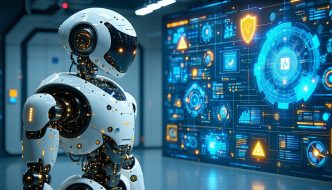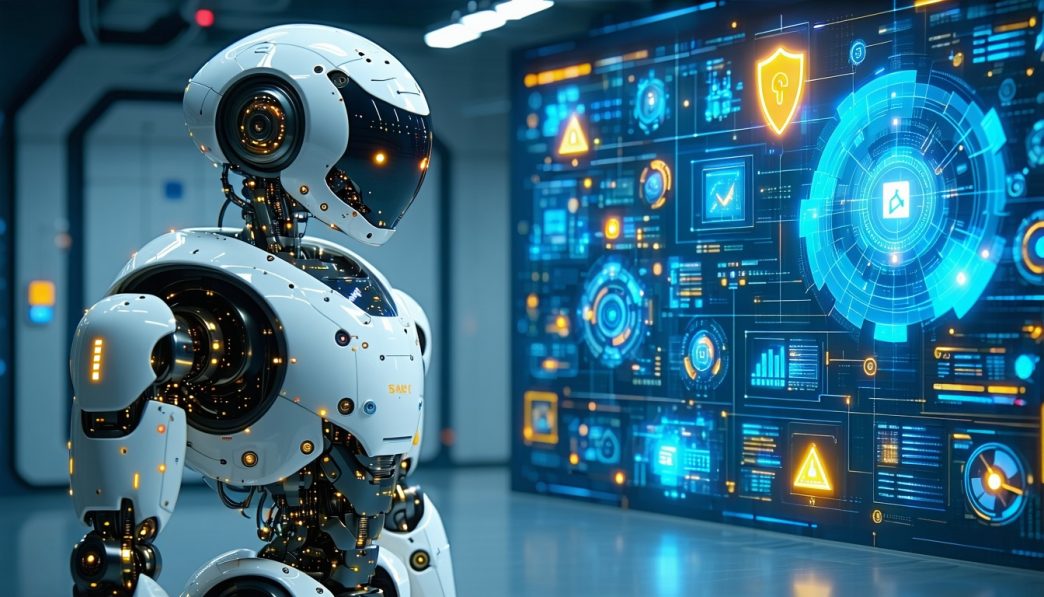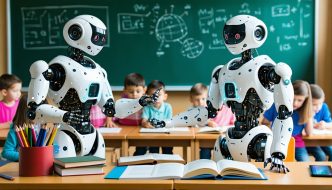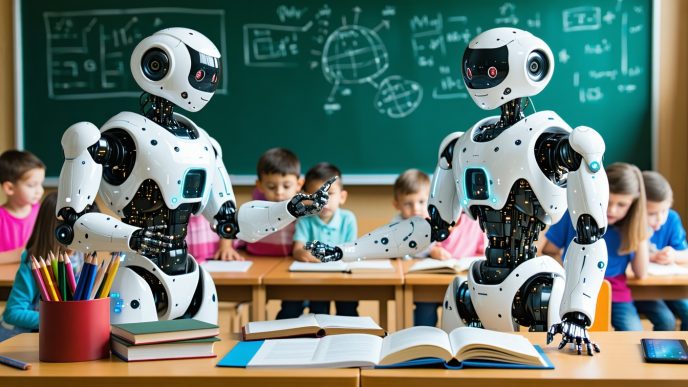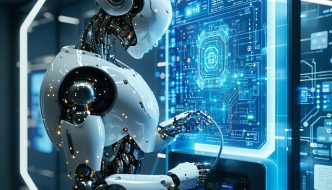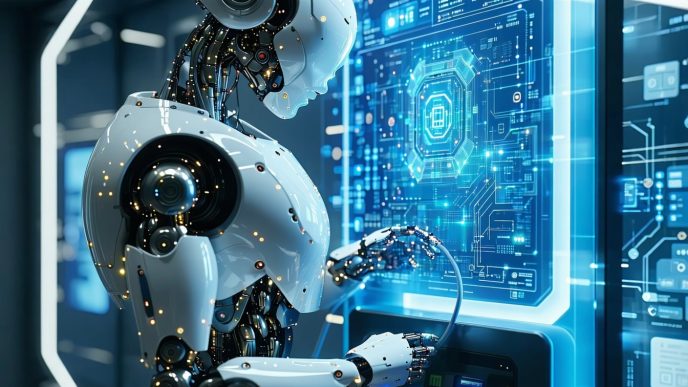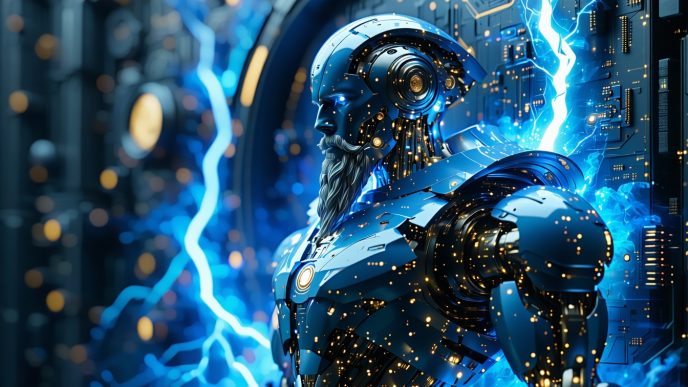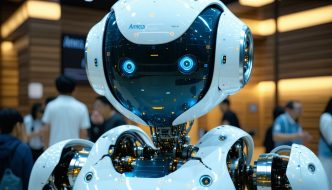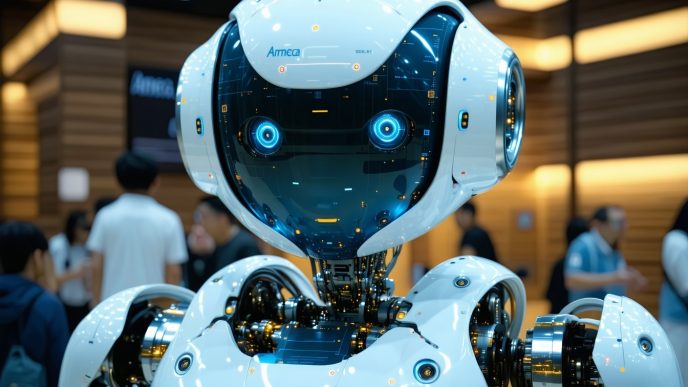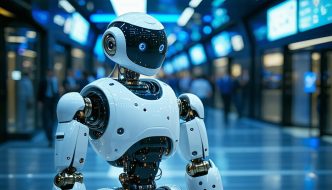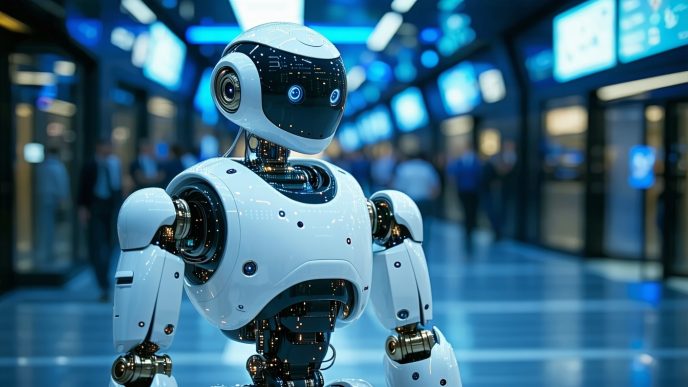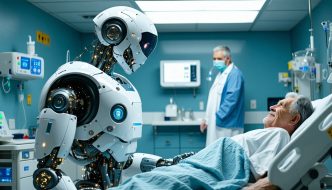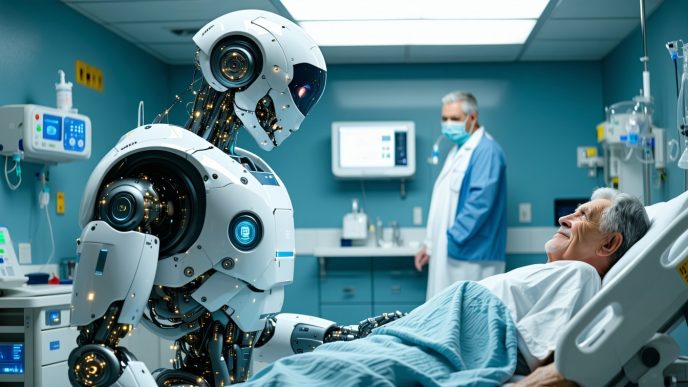The Evolution of Human-Robot Collaboration
The relationship between humans and robots has significantly evolved over the years, particularly in the realm of humanoid robots. These sophisticated machines have advanced beyond simple automation to engage in complex tasks alongside human workers.
Brief History of Humanoid Robots
Humanoid robots date back several decades, originating from early mechanical figures designed to mimic human motion. In the late 20th century, notable advancements in robotics technology led to the development of more sophisticated humanoid designs.
The early 2000s saw a surge in research and development, culminating in the introduction of robots like Honda’s ASIMO and Sony’s AIBO, which showcased capabilities such as walking and responding to commands. As technology progressed, recent innovations have produced impressive models such as the Tesla Optimus Robot and the Sanctuary AI Phoenix, which are capable of performing tasks in varied environments.
| Year | Robot | Notable Features |
|---|---|---|
| 2000 | ASIMO | Bipedal movement, obstacle avoidance |
| 2005 | AIBO | Interactivity, adaptability |
| 2022 | Tesla Optimus | Task execution in industrial settings |
| 2023 | Sanctuary AI Phoenix | Advanced learning and interaction |
Importance of Safety Protocols
As humanoid robots become increasingly integrated into workplaces and personal lives, the significance of safety protocols cannot be overstated. These protocols are essential to ensure that interactions between humans and robots are secure and effective.
Safety measures help mitigate risks associated with mechanical failures or unexpected behaviors. They include the implementation of humanoid robot safety systems that feature sensors for real-time detection of nearby humans, collision avoidance mechanisms, and emergency stop features.
Employing robust safety standards not only protects individuals but also instills trust in robotic technology, making it more likely for society to embrace these innovative machines. With the rapid development of humanoid robots, continuous updating and enhancement of safety protocols remain critical to support their growth and integration into various applications.
Understanding Humanoid Robots
Humanoid robots are designed to resemble human figures in both appearance and behavior. These machines incorporate various technologies to perform tasks that require human-like agility, adaptability, and interaction.
Definition and Characteristics
Humanoid robots can be defined as robots that possess a human-like form, typically featuring a head, arms, and legs aimed at mimicking human actions. Their characteristics often include:
- Mobility: Many humanoid robots can walk, run, or navigate space similarly to humans.
- Articulation: They are equipped with joints and limbs that allow for a range of movements, often using advanced locomotion systems.
- Social Interaction: Humanoid robots typically have built-in sensors and software to engage with humans effectively, utilizing voice interfaces and visual recognition.
| Characteristic | Description |
|---|---|
| Structure | Human-like form with limbs and sensors |
| Movement | Ability to walk and perform tasks |
| Interaction | Use of voice and facial recognition |
For a deeper look into the mechanical aspects of humanoid robots, see our article on humanoid robot locomotion systems.
Applications of Humanoid Robots
The applications of humanoid robots span various fields due to their adaptable nature. Some prominent uses include:
-
Healthcare: Humanoid robots assist in patient care, rehabilitation, and companionship, greatly contributing to elder care and mental health support. Learn more about this in our article on humanoid robots in healthcare.
-
Industrial Settings: These robots can perform repetitive tasks, assisting in manufacturing processes, quality control, and logistics. Special mention of their growing role can be found in our discussion of humanoid robots in logistics.
-
Domestic Assistance: Humanoid robots are increasingly being designed for home use, performing chores and providing companionship. For more examples, see our article on humanoid robots for daily chores and humanoid robots for home use.
-
Education: They serve as teaching tools in classrooms, aiding in interactive learning experiences. For insights, check our piece on humanoid robots for education.
| Application Area | Description |
|---|---|
| Healthcare | Assisting with patient care and companionship |
| Industrial | Supporting manufacturing and logistics |
| Domestic | Performing household tasks and chores |
| Education | Engaging students in interactive learning |
These multidimensional applications highlight the necessity of robust humanoid robot safety systems to ensure effective and safe interaction between humans and robots.
The Significance of Safety in Human-Robot Interaction
In the realm of humanoid robots, safety plays a crucial role in fostering an effective collaboration between humans and machines. Understanding the challenges and benefits associated with implementing comprehensive safety protocols is essential for industry professionals and developers alike.
Challenges of Human-Robot Collaboration
Human-robot interaction is not without its hurdles. Some key challenges include:
| Challenge | Description |
|---|---|
| Unpredictable Human Behavior | Humans can behave erratically, making it difficult for robots to anticipate actions. |
| Physical Proximity | Working in close quarters can lead to accidental collisions, posing safety risks. |
| Communication Barriers | Misunderstandings between humans and robots can arise due to a lack of effective communication systems. |
| Technological Limitations | Current robotic systems may struggle with real-time decision-making in dynamic environments. |
These challenges can hinder the efficiency and safety of human-robot collaboration. Addressing these issues through well-designed safety systems is essential for successful integration in various applications.
Benefits of Implementing Safety Protocols
Establishing robust safety protocols offers numerous advantages. Key benefits include:
| Benefit | Description |
|---|---|
| Enhanced Safety | Reduces the risk of accidents, ensuring a safer working environment for humans and robots. |
| Increased Efficiency | Streamlined operations lead to improved productivity when safety measures are in place. |
| Greater Trust | Building trust through safety protocols encourages humans to work collaboratively with robots. |
| Compliance with Regulations | Adhering to safety standards ensures compliance with industry regulations, mitigating legal risks. |
Implementing effective humanoid robot safety systems increases the overall comfort level of those interacting with robots. Safety not only protects individuals but also enhances the potential for deeper integration of humanoid robotics into everyday life.
Key Components of Humanoid Robot Safety Systems
Humanoid robot safety systems are designed to ensure the safe interaction between robots and humans. These systems consist of various components, including sensors and detection systems, collision avoidance mechanisms, and emergency stop features. Understanding each component helps promote safe cooperation in shared environments.
Sensors and Detection Systems
Sensors and detection systems play a critical role in maintaining safety. These systems allow humanoid robots to perceive their environment and detect the presence of nearby individuals or objects. The use of advanced sensors enhances the robot’s ability to respond quickly to changes around it.
Common sensor types include:
| Sensor Type | Purpose |
|---|---|
| Infrared Sensors | Detecting obstacles and proximity |
| Ultrasonic Sensors | Measuring distances and creating spatial maps |
| Lidar Sensors | Creating 3D maps of the environment |
| Cameras | Visual recognition of objects and people |
These sensors work together to provide real-time feedback, enabling the robot to make informed decisions while interacting in various settings. For more insights on how sensors contribute to humanoid robot safety, refer to our article on humanoid robot sensors.
Collision Avoidance Mechanisms
Collision avoidance mechanisms are essential for preventing accidents. These systems utilize data from sensors to navigate the environment safely. They calculate potential collision trajectories and adjust the robot’s movements accordingly to avoid contact with humans or obstacles.
Key features of collision avoidance include:
| Mechanism | Function |
|---|---|
| Reactive Control | Immediate responses during sudden encounters |
| Predictive Control | Anticipating obstacles before they appear |
| Path Planning | Calculating safe routes for navigation |
By incorporating these mechanisms, humanoid robots can operate confidently in dynamic environments, reducing the risk of injury to humans. Additional information on navigation technologies can be found in our article on humanoid robot navigation.
Emergency Stop Features
Emergency stop features are crucial for immediate cessation of robot activity in case of potential danger. This feature ensures that both human operators and bystanders can intervene quickly if a situation escalates.
Important aspects of emergency stop features include:
| Feature | Description |
|---|---|
| Manual Emergency Stop Button | Allows humans to halt robot operation instantly |
| Automatic Shutdown | Activates automatically based on sensor triggers |
| Alerts | Provides audible or visual warnings when engaged |
The effectiveness of emergency stop features contributes significantly to overall safety and confidence in human-robot collaboration. For further guidelines on maintaining safe practices during robot interaction, see our article on humanoid robot maintenance.
Ensuring Safe Cooperation
To promote a harmonious working environment between humans and humanoid robots, several measures must be taken. This section focuses on essential aspects such as training programs, regular maintenance, and communication standards that play a critical role in ensuring safety.
Training Programs for Humans and Robots
Effective training programs are vital for both human operators and humanoid robots. Humans must understand the capabilities and limitations of the robots they work with. Training sessions should cover the following topics:
| Training Component | Description |
|---|---|
| Safety Protocols | Understanding safety measures to prevent accidents and injuries. |
| Robot Operations | Learning how to interact with and control humanoid robots effectively. |
| Emergency Procedures | Knowing how to respond in case of malfunctions or emergencies. |
Training for humanoid robots also includes programming their behavior and responses in various environments. This ensures that they can operate safely and efficiently alongside humans.
Regular Maintenance and Inspections
Routine inspections and maintenance are crucial components of humanoid robot safety systems. Regular checks help identify potential issues before they become significant problems. Key maintenance tasks include:
| Maintenance Task | Frequency |
|---|---|
| Software Updates | Monthly |
| Mechanical Checks | Quarterly |
| Sensor Calibration | Biannually |
Proper maintenance not only extends the lifespan of humanoid robots but also enhances their performance and safety. Implementing a consistent maintenance schedule can help avoid unexpected failures that could lead to accidents.
Communication Standards in Human-Robot Interaction
Establishing clear communication standards is essential for effective interaction between humans and humanoid robots. Effective communication ensures that both parties understand commands and signals clearly. Important aspects of communication standards include:
| Communication Aspect | Description |
|---|---|
| Voice Interfaces | Implementing intuitive voice commands for seamless interaction. Visit our article on voice interfaces in humanoid robots for more info. |
| Visual Signals | Using lights or screens on the robot to indicate status or intent. |
| Feedback Mechanisms | Encouraging robots to provide feedback to human operators about tasks and conditions. |
By enhancing communication patterns, misunderstandings can be reduced, leading to safer and more efficient cooperation in environments where humanoid robots are deployed.
Case Studies: Humanoid Robot Safety in Action
Humanoid robots have increasingly integrated into various fields, showcasing their versatility and effectiveness. This section examines real-world applications of these robots in industrial settings, healthcare, and domestic assistance, highlighting the importance of safety systems in each context.
Industrial Settings
In manufacturing and assembly lines, humanoid robots have revolutionized production workflows. These robots collaborate with human workers to enhance efficiency while maintaining safety. The implementation of advanced humanoid robot safety systems includes features like collision detection and automated emergency stops.
| Robot Type | Safety Features | Example Applications |
|---|---|---|
| Agility Digit Robot | Proximity sensors, emergency stop | Assembly lines, material handling |
| Unitree G1 Robot | Motion tracking, safe distance markers | Packaging, quality assessment |
| Robotics Unlimited Zeus | Collision avoidance, soft robotic arms | Heavy lifting, automated assembly |
These robots are equipped with sensors to monitor their surroundings, enabling them to adapt to human movements and avoid accidents.
Healthcare Applications
In healthcare settings, humanoid robots assist healthcare professionals by providing support to patients and managing routine tasks. Safety protocols are crucial in these environments where patient care is paramount. The humanoid robot safety systems implemented include secure interaction protocols and real-time monitoring of the robot’s actions.
| Robot Type | Safety Features | Example Applications |
|---|---|---|
| Sanctuary AI Phoenix | Voice interfaces, fall detection | Patient assistance, mobility support |
| Xiaomi CyberOne | Sensor-based navigation, patient monitoring | Rehabilitation support, companionship |
| Ameca Robot by Engineered Arts | Emotion recognition technology | Social interaction, therapy sessions |
These safety features ensure that robots can communicate effectively with both healthcare staff and patients, enhancing care quality while ensuring safety.
Domestic Assistance Robots
Humanoid robots designed for home use provide numerous benefits, such as assistance with daily chores and companionship. Safety is a top priority, as these robots often operate in close proximity to family members, including children and the elderly. Implementing reliable humanoid robot safety systems is essential for preventing accidents.
| Robot Type | Safety Features | Example Applications |
|---|---|---|
| Humanoid Robots for Kids | Child-safe designs, motion sensors | Educational purposes, playtime |
| Humanoid Robots for Home Use | Customized voice commands, obstacle detection | Cleaning, elder care |
| Humanoid Robots for Daily Chores | Remote control, automated alerts | Food preparation, laundry assistance |
These safety systems help ensure smooth operation while allowing robots to perform their tasks without compromising the safety of users.
By examining these case studies, it becomes evident that robust safety protocols are vital for effective human-robot collaboration across different sectors.
Future Developments in Human-Robot Safety
As technology advances, the safety protocols surrounding human-robot interactions will also evolve. This section explores two key areas of development: advancements in sensor technology and enhanced AI for predictive safety measures.
Advancements in Sensor Technology
The integration of advanced sensor technology is vital for improving humanoid robot safety systems. Cutting-edge sensors enable robots to detect their environment, understand human movements, and respond appropriately. Various types of sensors play a role in enhancing the safety of humanoid robots.
| Sensor Type | Description | Application |
|---|---|---|
| Proximity Sensors | Detect nearby objects and humans | Collision avoidance |
| LIDAR | Creates high-resolution maps of the surroundings | Navigation and spatial awareness |
| Infrared Sensors | Measure heat signatures | Ensuring safe interactions with humans |
| Cameras | Visual recognition for identifying people and obstacles | Gesture recognition and hazard detection |
Through improved sensor capabilities, humanoid robots can monitor their surroundings and make safer decisions during interactions with humans. This continuous awareness significantly reduces the likelihood of accidents, making environments safer for all.
Enhanced AI for Predictive Safety Measures
Artificial intelligence (AI) technology is also playing a crucial role in the future of humanoid robot safety systems. Enhanced AI models can analyze data from various sensors and predict potential risks during human-robot interactions.
With machine learning algorithms and real-time data analysis, robots can learn from their experiences and refine their safety protocols. Improved AI capabilities facilitate:
| AI Feature | Functionality |
|---|---|
| Predictive Analytics | Anticipates human actions based on previous behavior |
| Adaptive Learning | Adjusts robot behavior according to environmental changes |
| Risk Assessment Models | Evaluates potential hazards and implements safety measures |
Research into AI applications, such as emotion recognition in robots, also enhances communication and understanding between humans and robots. This contributes to a safer working environment, as robots can respond to human emotions and actions in real-time. For more on AI in humanoid robots, check ai models in humanoid robots.
In summary, the future of humanoid robot safety will be shaped by advancements in sensor technology and AI, creating a safer and more effective collaboration between humans and robots.
